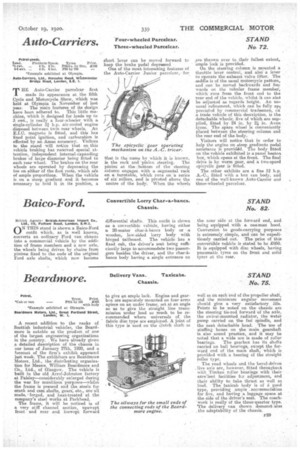Beardmore.
Page 37

If you've noticed an error in this article please click here to report it so we can fix it.
Delivery Vans. Taxicabs.
Chassis.
STAND No. 75.
A recent addition to the ranks of Scottish industrial vehicles, the Beardmore is notable as the product of one of the largest engineering organizations in the country. We have already given a detailed description of the chassis in our issue of January 27th, 1920, and a forecast of the firrnrs exhibit appeared last week. The exhibitors are Beardmore Motors Ltd., the distributing organization for Messrs, William Beardmore and Co., Ltd., of Glasgow. The vehicle is built in the old Arrol-Johnston factory at Paisley—considerably enlarged during the war for munitions purposes—whilst the frame is pressed and the steels for wank and cam shafts, gears:, etc., are all made, ' forged, and heat-treated at the
company's steel works at Paxkhead. . The frame, it will be noticed is of a very stiff channel section, upswept front and rear and inswept forward to give an ample lock. Engine and gearbox are Separately mounted on four arms apiece on an under frame, set at an angle so as to give the straight line transmission under load so much to be recommended where universals of the fabric disc type are employed. A joint of this type is used oti the clutch shaft as
well as on each lend of the, propeller shaft, and the minimum angular movement should give a very satisfactory. life. Points to be noted on the chassis are the steering tie-rod forward of the axle, the swivel-mounted radiator, the water pump carried on the faff spindle, and the neat detachable head. The use of stuffing boxes on the main gearshaft is also sound practice, and it may be noted that a wide use is made of roller bearings. The gearbox has its shafts carried on ball bearing* except. the forward end of the main shaft, which is provided with a bearing of the straight roller type.
The road wheels and the bevel-driven . live axle are, however, fitted throughout with Timken roller hearings with their excellent facilities fcr adjustment, and their ability to take thrust as well as load. The taxicab body is of I good typo, providing ample .accommodation for five, and halting a luggage space at the side of the driver's seat. The coachwork is really of the three-quarter type. 'The delivery van shown &mond: ates the adaptability of the chassis.












































































